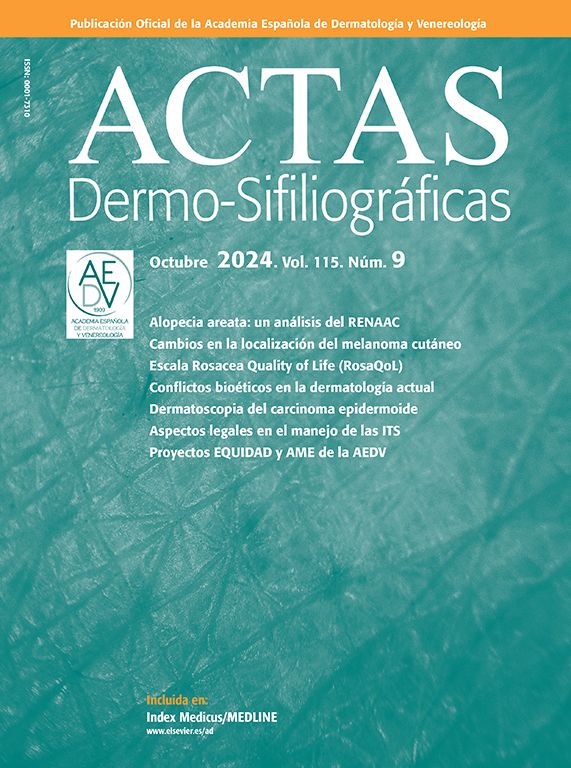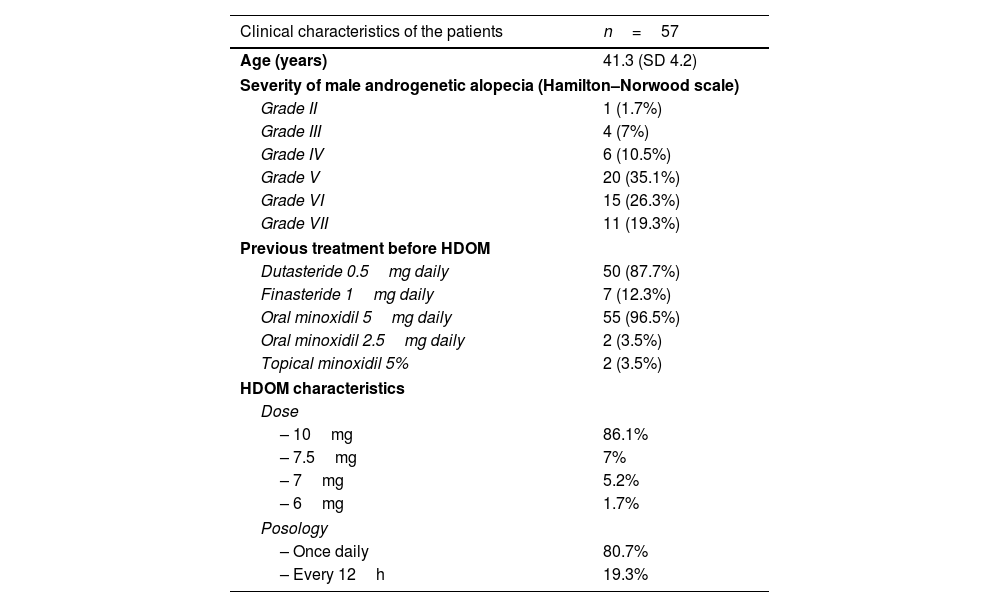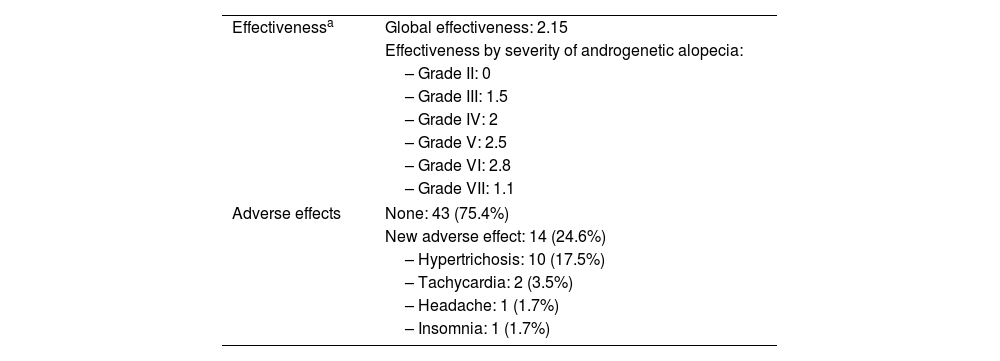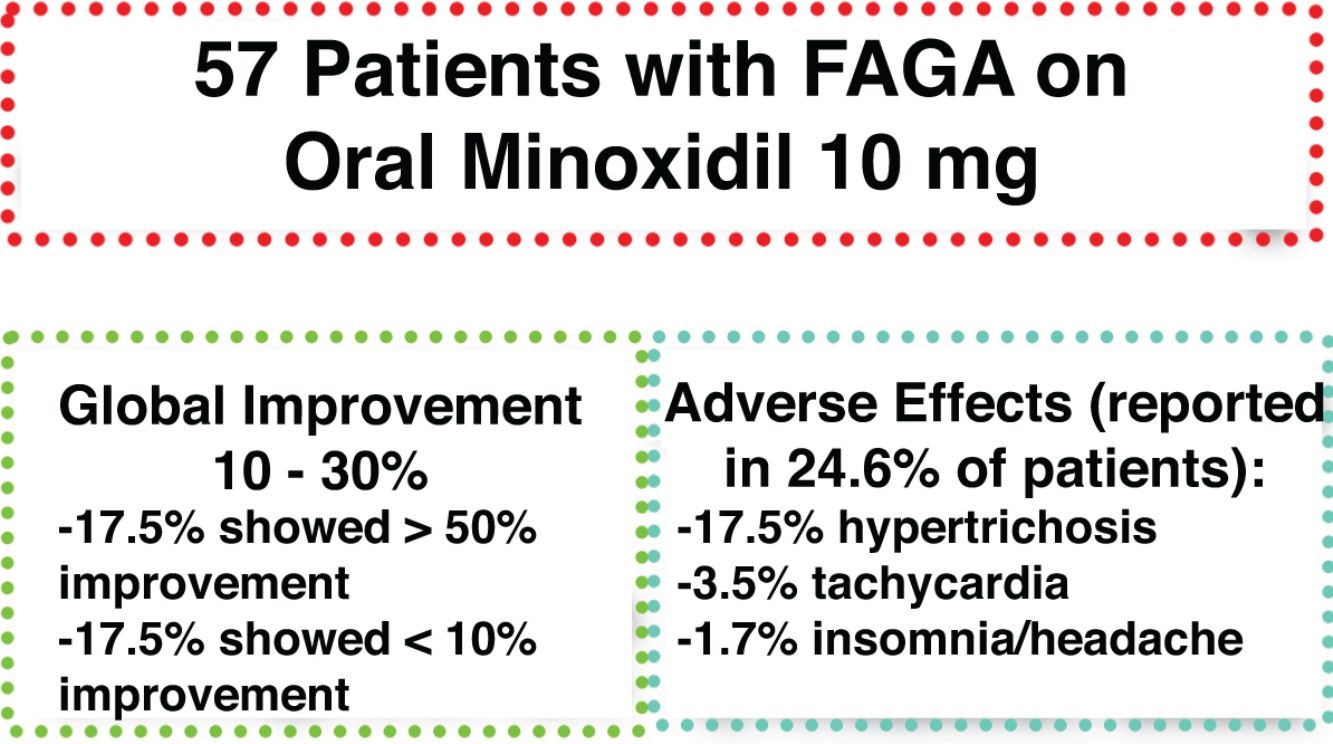Low-dose oral minoxidil (≤5mg daily) has emerged as an effective off-label treatment for androgenetic alopecia, outperforming topical minoxidil in terms of adherence. However, the optimal dose has not yet been determined, and high doses may cause systemic adverse effects. This retrospective study of 57 patients evaluated the safety and efficacy profile of oral minoxidil at higher doses (>5mg). Results showed an overall improvement in hair density between 10–30% in most patients, although with variable responses. A total of 17.5% of patients experienced significant improvements (>50%), while another 17.5% improved <10%. A quarter of the patients (24.6%) developed adverse effects, such as hypertrichosis (17.5%) and tachycardia (3.5%). Although it is a promising therapeutic option, higher doses of oral minoxidil require further studies to optimize its use and better understand its safety and efficacy profile.
El minoxidil oral a dosis bajas (≤5mg diarios) ha surgido como un tratamiento fuera de indicación efectivo para la alopecia androgenética, superando al minoxidil tópico en términos de adherencia. Sin embargo, la dosis óptima aún no se ha determinado, y altas dosis pueden causar efectos adversos sistémicos. Este estudio retrospectivo en 57 pacientes evaluó la efectividad y seguridad del minoxidil oral en dosis mayores (>5mg). Los resultados mostraron una mejoría global en la densidad capilar del 10-30% en la mayoría de los pacientes, aunque con variabilidad en la respuesta. Un 17,5% experimentó mejoras significativas (>50%), mientras que otro 17,5% mejoró menos de un 10%. Un 24,6% de los pacientes desarrollaron efectos adversos, como hipertricosis (17,5%) y taquicardia (3,5%). Aunque es una opción terapéutica prometedora, las dosis mayores de minoxidil oral requieren más estudios para optimizar su uso y comprender mejor su perfil de seguridad y eficacia.
Low-dose oral minoxidil (LDOM), not exceeding 5mg daily, is an emerging off-label treatment for androgenetic alopecia.1,2 Scientific evidence on its effectiveness has consolidated in recent years,3–6 and despite its off-label use, it is displacing topical minoxidil in its indication given the greater therapeutic adherence of patients and its mechanism of action independent of follicular sulfotransferase. Although there is increasing evidence about its safety profile,3–6 the optimal dose for patients with alopecia has not yet been defined and it can have systemic adverse effects at high doses.7 The objective of this study is to describe the safety and efficacy profile of high-dose oral minoxidil (HDOM) (>5mg every 24h) for the treatment of androgenetic alopecia.
Material and methodsWe conducted a retrospective multicenter study was designed that collected data from 57 patients who had received HDOM for at least 9 months for their androgenetic alopecia in one center in Brazil and 2 in Spain. The inclusion criterion required that patients had been on doses of 5mg or less (LDOM) in the year prior to the increase in oral minoxidil dose.
The improvement in hair density was clinically evaluated by comparing clinical images before HDOM and after the patient's last clinical follow-up according to an ordinal scale ranging from 0 (no improvement), 1 (<10% improvement – clinically non-significant–), 2 (improvement between 10 and 30%), 3 (improvement between 30 and 50%), and 4 (>50% improvement in hair density).
ResultsOverall, 57 male patients with a mean age of 41.3 years (SD, 4.2 years) who had been on HDOM for at least 9 months (range 9–12 months) were recruited (Table 1). A total of 15 patients (26.3%) used commercial oral minoxidil (Loniten®, Pfizer) and the rest, compounded medication from the pharmacy. The daily dose was 10mg (86.1% of patients), 7.5mg (7%), 7mg (5.2%), and 6mg (1.7%). Most patients (80.7%) took a single daily dose of the drug before bedtime, while the rest divided the daily dose into 2 separate doses 12h apart. All patients, except for 2, had already been on maximum doses of LDOM (5mg) the previous year.
Clinical characteristics of the patients.
| Clinical characteristics of the patients | n=57 |
|---|---|
| Age (years) | 41.3 (SD 4.2) |
| Severity of male androgenetic alopecia (Hamilton–Norwood scale) | |
| Grade II | 1 (1.7%) |
| Grade III | 4 (7%) |
| Grade IV | 6 (10.5%) |
| Grade V | 20 (35.1%) |
| Grade VI | 15 (26.3%) |
| Grade VII | 11 (19.3%) |
| Previous treatment before HDOM | |
| Dutasteride 0.5mg daily | 50 (87.7%) |
| Finasteride 1mg daily | 7 (12.3%) |
| Oral minoxidil 5mg daily | 55 (96.5%) |
| Oral minoxidil 2.5mg daily | 2 (3.5%) |
| Topical minoxidil 5% | 2 (3.5%) |
| HDOM characteristics | |
| Dose | |
| – 10mg | 86.1% |
| – 7.5mg | 7% |
| – 7mg | 5.2% |
| – 6mg | 1.7% |
| Posology | |
| – Once daily | 80.7% |
| – Every 12h | 19.3% |
SD: standard deviation; HDOM: high-dose oral minoxidil.
In all patients, HDOM treatment was added to the previous treatment for their androgenetic alopecia (dutasteride 0.5mg daily (87.7%), finasteride 1mg daily (12.3%), oral minoxidil 5mg daily (96.5%), oral minoxidil 2.5mg daily: 2 (3.5%) or topical minoxidil 5%: 2 (3.5%), which was continued. Ten patients (17.54%) were on medical therapy for hypertension. Hypertensive patients were advised to monitor their blood pressure (BP) at home daily for 1 week and to report any significant decrease in BP (<120/80), dizziness, or tachycardia. Normotensive patients were only instructed to contact in case of any adverse effects.
Regarding effectiveness (Table 2), 4 patients (7%) did not achieve any improvement in hair density after the transition from LDOM to HDOM; 10 patients (17.5%) improved <10%, 26 patients (45.6%) improved between 10 and 30%, 7 patients (12.2%) improved between 30 and 50%, and 10 patients (17.5%) improved >50%. The overall effectiveness, valued as the mean, was 2.15 (improvement between 10 and 30% in hair density). No statistically significant association was found between the severity of androgenetic alopecia and the efficacy of HDOM, although patients with grades II and VII on the Hamilton-Norwood scale had the worst response.
Safety and effective profile of HDOM.
| Effectivenessa | Global effectiveness: 2.15 |
| Effectiveness by severity of androgenetic alopecia: | |
| – Grade II: 0 | |
| – Grade III: 1.5 | |
| – Grade IV: 2 | |
| – Grade V: 2.5 | |
| – Grade VI: 2.8 | |
| – Grade VII: 1.1 | |
| Adverse effects | None: 43 (75.4%) |
| New adverse effect: 14 (24.6%) | |
| – Hypertrichosis: 10 (17.5%) | |
| – Tachycardia: 2 (3.5%) | |
| – Headache: 1 (1.7%) | |
| – Insomnia: 1 (1.7%) | |
HDOM: high-dose oral minoxidil.
The change from LDOM to HDOM led to the appearance of a new adverse effect in 14 patients (24.6%). An increase in hypertrichosis occurred in 10 patients (17.5% overall), compensatory tachycardia in 2 (3.5%), headache in 1 patient, and insomnia in 1. In the 2 cases of tachycardia, the dose had to be down titrated to the previously tolerated LDOM dose (5mg). These patients had no other comorbidities and were not on any other drugs, but used the compounded medication. Hypertensive patients did not develop any side effects. No other adverse effects were observed.
DiscussionThe advent of oral minoxidil for the treatment of androgenetic alopecia, cicatricial alopecia, persistent alopecia due to chemotherapy, or even pediatric alopecia has revolutionized therapeutics in trichology1,8 given the current context of limited treatments that have demonstrated real effectiveness for hair improvement.
The improvement in hair density when increasing the dose of oral minoxidil above 5mg daily was globally between 10% and 30%. This improvement is not particularly striking vs other drugs such as 5-alpha-reductase inhibitors (finasteride or dutasteride) although, for a patient with androgenetic alopecia who cannot or does not want to undergo a hair transplant, it may be an option to consider. However, a small percentage of patients showed no improvement, suggesting that the response to HDOM can vary considerably between individuals. Finally, 17.5% of patients experienced notable improvements (>50% in their hair density), which underscores the potential of HDOM as an effective therapeutic option for certain patients with androgenetic alopecia resistant to conventional therapy.
Regarding its safety profile, the increase in oral minoxidil dose seems to be clearly associated with an increase in facial and body hair, with a worsening observed in 17.5% of patients. In general, this is irrelevant in men; but in women, this possibility and control methods should be discussed. In 2 of the 57 patients (3.5%), episodes of reflex tachycardia to hypotension were reported. This low prevalence is reassuring and is aligned with what has been previously published9 at doses of 7.5mg daily not associated with clinical tachycardia. In our opinion, to maximize the safety profile of oral minoxidil, the best thing to do is to perform a sequential increase in dose, similar to its use for hypertension described in its technical data sheet.10 In the absence of adverse effects, we usually increase the dose from 2.5mg to 5mg after 6 months of treatment and subsequently, from 5mg to 10mg after 1 year. Although it is beyond the scope of this study, we have the impression that even at low doses there is a compensatory biological mechanism that helps to reduce its adverse effects if the dose is increased progressively, as used decades ago to treat refractory hypertension due to systemic lupus with doses>20–50mg daily. On the other hand, hypertensive patients did not experience additional adverse effects, indicating that HDOM may be a safe option for this subpopulation, provided that adequate BP monitoring is performed.
Despite the promising results, this study has certain limitations that should be taken into consideration. The sample size was relatively small, which may limit the generalization of the findings to a larger population. Furthermore, the study focused exclusively on men, so the results cannot be directly extrapolated to women with androgenetic alopecia. In addition, the variability in response to treatment suggests that more research is needed to identify the factors that predict a better response and to optimize individualized treatment for androgenetic alopecia.
Future studies with larger and more diverse samples would be necessary to validate these findings and further explore HDOM.
Conflicts of interestNone declared.








